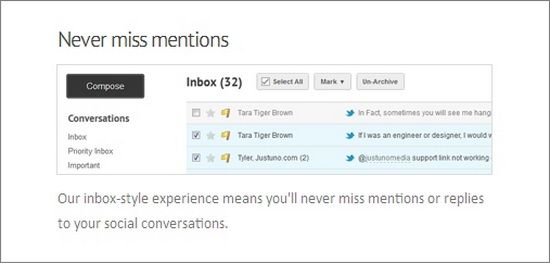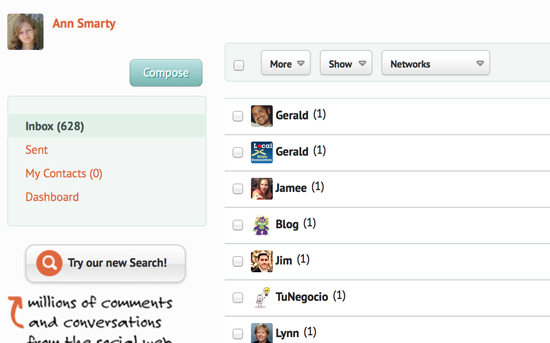Continued from last post...
3. Make a connection
From a high level view, this strategy comes down to your perspective with social media.It’s an honor and a privilege for someone to reach out to you on social media, amid the millions of other profiles and accounts to connect with.
When someone chooses to chat with you, be grateful, and respond.
Zappos, well known for its awesome customer service over the phone and online, has the following response numbers:
- Response Time: < 20 min
- Response Rate: 100 percent
In the book Traction, Gabriel Weinberg and Justin Mares talk about 19 traction channels to help gain more customers. One of these channels is unconventional PR, which includes customer service.
You can be so great at customer service that it becomes free, unconventional PR for your brand!
Consider: The average top brands worldwide tweet at least 12 times a day, and 54 percent of these brands are sending less than one @-reply per day.
There’s a lot of room to improve (and stand out) amid those numbers.
What this might look like in practice
When possible, connect 24/7 with your audience.When not possible—and totally understandable if you’re a small business or a one-person team—communicate your availability.
Zappos does the 24/7 thing in a cool way by having their Twitter support team say hello and good-bye as they change shifts.
American Express gives us a good example of how to communicate when you turn off for the night.
Another way to make a one-to-one connection or conversation is through Direct Message.
Our co-founder Leo wrote a great article on Social Media Examiner about Twitter and customer service, and he laid out this quick 3-step guide for what to do when you’re communicating with your many people in your audience about a similar topic or bug.
Send one public tweet explaining the situation. Anyone who finds your Twitter profile will see that tweet first.DMs are also a great alternative to the “please send an email to name@company.com” line. You make a connection with your customer without sending them elsewhere to talk to you and dragging out the process unnecessarily.
Then, reply to any @mentions with a DM. First, you won’t clutter your business’s Twitter stream with @replies for other customers looking for what is going on. Second, you can go into more detail explaining how you can help each customer.
Switch back to sending @replies if there is no acute problem anymore, but only regular questions and support requests.
DMs are also extremely useful when a simple @reply doesn’t give all of the information the customer needs.
What happens if you don’t
Not only do you risk alienating your community by not responding, you can also create harmful reactions to your brand. A research study in the Academy of Management found that companies who accepted responsibility for a problem saw favorable responses. Those who were slow in responding to complaints did not. It’s all a quite intuitive conclusion, though interesting to see backed by research in addition to intuition.4. Be specific
This strategy is one borrowed from email marketing, where specificity—often seen in the form of segmentation and personalization—is a key driver of higher open rates and clickthrough rates.A study by Jupiter Research found that relevant emails drove 18 times more revenue than general, broadcast emails.
Shane Snow and Jon YouShaei tested specificity in a series of cold emails, changing things like the subject line and the thank you message to see what worked best. Of the cold emails, sent in impersonal batches, only 1.7% of people replies, 12 out of 700.
Following the study, Shane cold emailed a single contact with a highly personalized email. He got a reply.
Here’s the email Shane sent:
Subject: Shook your hand at NextJump, would love your advice
Adam,
Fantastic presentation at NextJump yesterday! I was thrilled to shake your hand and say “thanks” right before you ran out. I was also happy to see your book hit the Print+Ebook bestseller list in the Times Book Review last week. The world needs this message.
I feel apprehensive asking you this, since I know you have plenty of opportunities to give already, but I wanted to know if, when the frenzy dissipates, you would be willing to coach me a bit on the work I’m doing for my first book? I just signed an exciting deal with HarperCollins (my editor, Hollis Heimbouch, works with Clayton Christensen and Jim Collins) for a book that I’m hoping will help a LOT of people. (It’s inspired, in fact, by XXXpersonal storyXXX.)
I’d love to tell you more about the book, which is provisionally titled Smartcuts, and pick your brain for one of my chapters. But most of all, I’d be delighted to get your advice on managing the whole process as well as you have. Perhaps we can grab a few minutes at your office or here in New York sometime?
Best wishes,
Shane
What this might look like in practice
Replying with specificity to your customers is a wonderfully smart and simple habit to get into. All it takes is a bit of notice.When someone mentions you on Twitter, you can click on their username to see a popover with their bio and information.

What you might get from here:
- Location – “Hope the weather’s great in Boston!”
- Website – “Love the design on your site. :)”
- Favorite teams – “How’re the Red Sox doing?”
- School or alma mater – “Go ‘Cats!”
- Interests/passions – (attach a picture or gif)
- Work – “Hope all’s going great at CompanyX!”
What happens if you don’t
There aren’t too many downsides to an impersonal Twitter response. A response, any response, is better than none.Personalization is what can help take your conversations from everyday to extraordinary. If you aim to delight your customers at every turn, then personalization in your social media replies is a great route to consider.
5. Say their name
“Remember that a person’s name is to that person the sweetest and most important sound in any language.” ~ Dale CarnegieA Ball State study found that addressing customers by their real name is considered a best practice of brands on social media.
And certainly, the psychology backs it up.
“You” or your name is considered to be one of the five most persuasive words in the English language.
Some of the biggest brands in the world rely on this personal touch with their interaction. In the book High-Tech, High-Touch Customer Service, Micah Solomon shares an acronym used by Apple to help inform its customer conversations.
Apple takes the overall goal to … “Present a solution for the customer to take home today.”
And they seek to achieve this with the following acronym:
A – Approach customers with a personalized, warm welcome
P – Probe politely to understand all the customer’s needs
P – Present a solution for the customer to take home today
L – Listen for and resolve any issues or concerns
E – End with a fond farewell and an invitation to return

What this might look like in practice
In most cases, the customer’s first name will be easy enough to find on their profile. Twitter bios, for instance, allow for a username (the @-handle the person chooses) and for a first and last name.
Take a quick peek at the name before replying, and you can easily add it in to your tweet or comment.
What happens if you don’t
Like personalized messages, adding someone’s name is neither a deal-maker nor a deal-breaker. It’s just another nice touch. And all these nice touches could very well add up to something quite meaningful over time.Over to you
What strategies have you found most helpful in replying to people on social media?I’d love to learn any of your tips on the subject. Feel free to leave any thoughts at all here in the comments!
https://blog.bufferapp.com/happy-customers-social-media?utm_source=feedburner&utm_medium=feed&utm_campaign=Feed%3A+bufferapp+%28Updates+and+tips+from+Buffer%29







